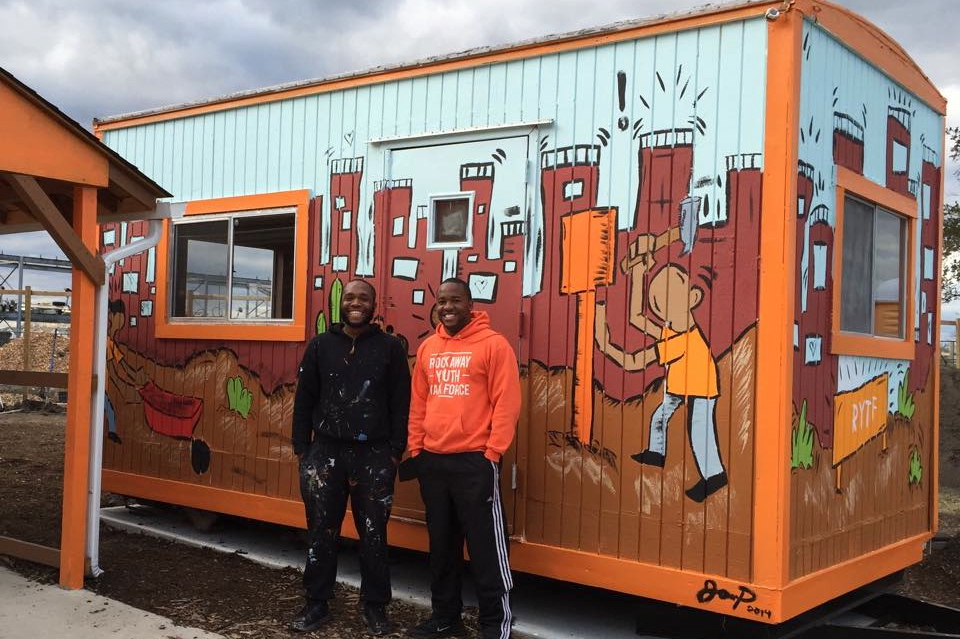Milan Taylor, the 25-year old chief executive officer of the Rockaway Youth Task Force, an organization he founded to create civic leadership opportunities for teens and young adults who live on the eastern end of the peninsula, said he had his flash of post-Sandy awareness when he saw a line of local residents at a fire hydrant on Beach 40th Street, filling bottles because their high-rise apartment buildings didn’t have water.
“That’s when I realized that we needed to start organizing,” he said.
Taylor also realized that without working elevators, older residents wouldn’t be able to leave their buildings to find food and other resources. So he asked task force members to go door-to-door and find out who needed help.
For a solid week, members operated a distribution hub where they assembled aid packages of water, food, batteries, and blankets. They also coordinated volunteers who answered calls on the task force’s Facebook page to come to Far Rockaway, pairing groups of them with locals who knew the neighborhood.
Taylor, who spoke to me at the task force’s headquarters near the A train station on Mott Avenue, also lived in a building without power and heat. At one point, he said, he became overwhelmed.
“I’ve never managed volunteers in the hundreds before, and everyone coming to me with their personal issues, asking for directions, how to get back home, and I’m thinking, ‘well, how am I going to stay warm tonight,’” he said.
He spent part of one day taking a solo walk. He expected the volunteers to be gone when he returned, but found that “things were running smoother than ever.” The experience taught him something valuable: the Rockaway Youth Task Force could function with other members at the helm.
“I really think that’s what Sandy provided, just an opportunity for everyone to step up, and just show what they’re made of,” he said.
He also witnessed the reach of social media. The task force already had a large following on its Facebook page when it posted a request for donations of food and other supplies; Taylor doesn’t know how, but the request reached the website of the New York City Public Advocate, current Mayor Bill de Blasio, he said. In Taylor’s office, a wall chart displayed the task force’s main social media numbers as of August 2014: approximately 13,000 likes on Facebook, and approximately 14,000 followers on Twitter.
Taylor also said that building a resourceful social network can be challenging for some of the community members he grew up with in Arverne, a neighborhood about a ten-minute drive from the task force’s headquarters.
“One of the biggest thing about personal networks...if you’re unemployed, if you’re from a low-income community, usually that’s who you associate with,” he said. “If you only know people who are in a similar situation as yourself and you put out a call on social media, I really doubt those individuals can help you.”
That’s one of the reasons he thinks the task force’s work is important. He praised Chief Operations Officer Silaka Cox, 19, who helped organize volunteers during Taylor’s head-clearing walk and spoke at the People’s Climate March in Manhattan on September 21, 2014, as well as Senior Field Organizer Khaleel Anderson, 18, for their effort after the storm.
Members of the task force receive training in using social media. Taylor said that it requires a shift in approach to the medium.
“You have to give up some of the fun,” he said. “A lot of times young people see social media as an outlet to kind of be who they think they are, or who they’d like to be, and sometimes you just have to be yourself.”
That stance can facilitate interactions that establish broader networks.
“That’s why we especially focus on...getting to know people outside of your comfort zone,” Taylor said. “Because you never know how they can help you down the road.”
When we started speaking, Taylor said that his community was experiencing multiple problems before the storm, including high unemployment, teen pregnancy, and gang violence. He also said that things in Rockaway “look better” almost two years later, and that “it’s continuing to be a vibrant place where people want to come and grow.”
Part of that vibrancy comes from a community garden that the task force started building in October 2013, in a lot on Beach 58th Street that’s visible from a window in Taylor’s current and childhood home.
“The fact that this vacant lot, that I vividly remember looking at when I was younger, is now turning into a garden where people can grow fruits and vegetables is a really proud moment for me,” he said.” [I] kind of feel like everything’s coming full circle.”

